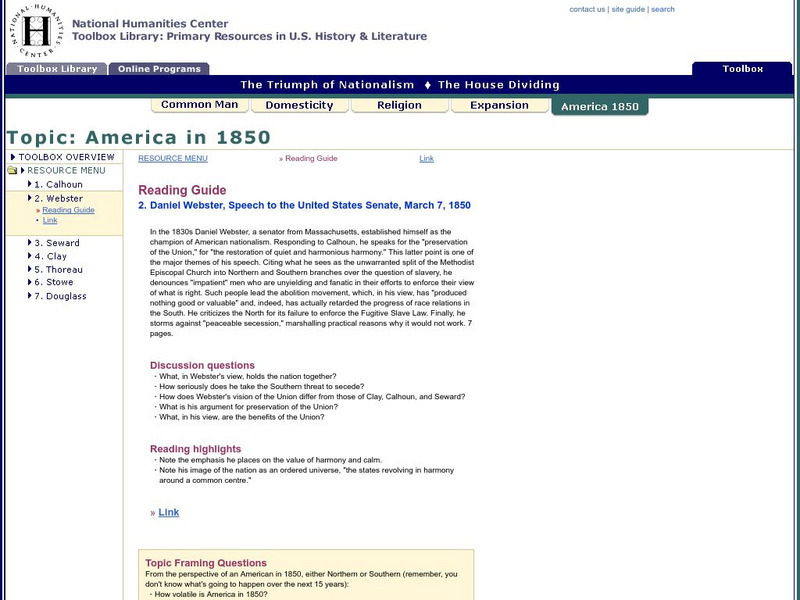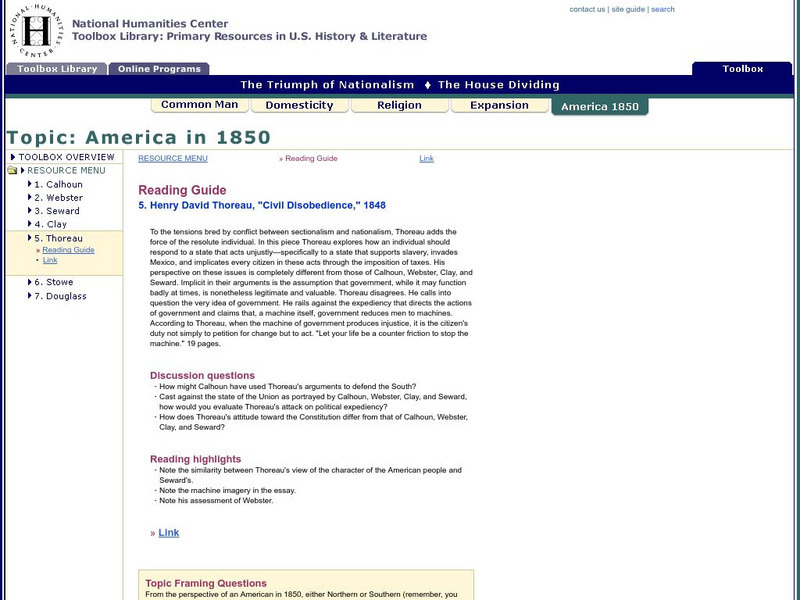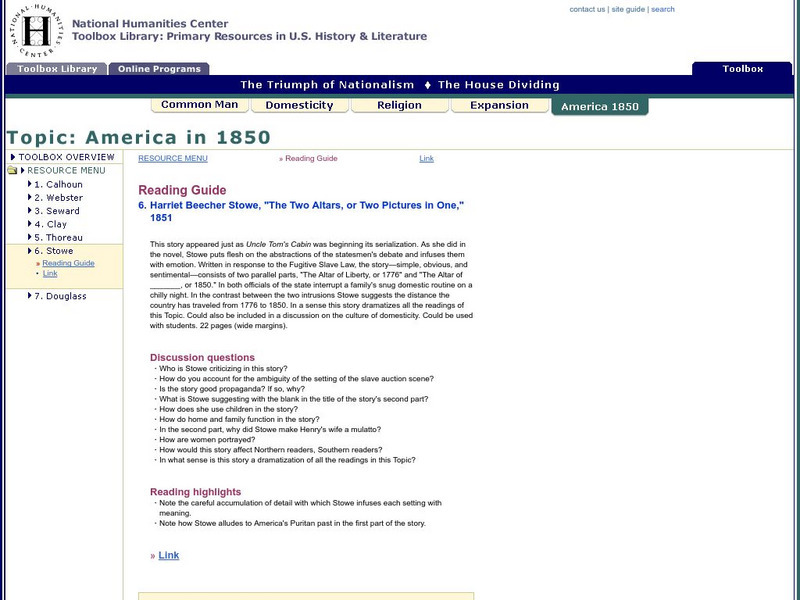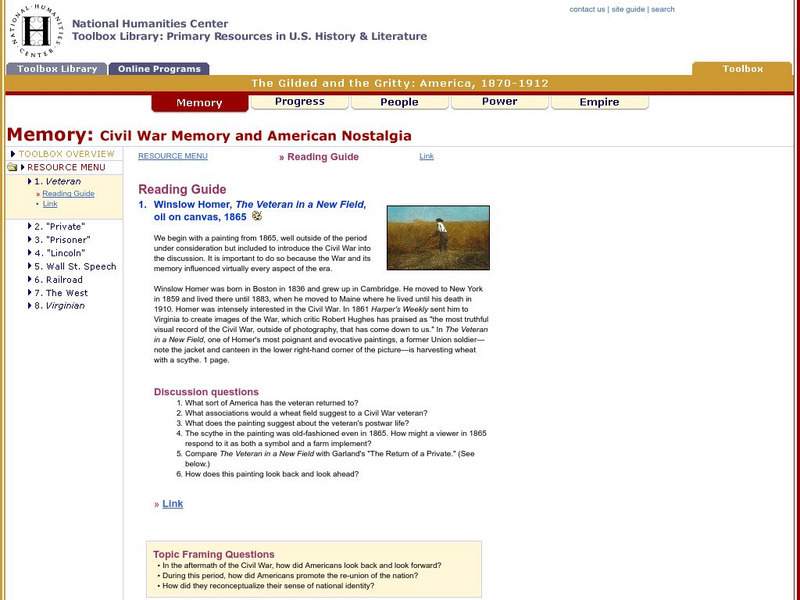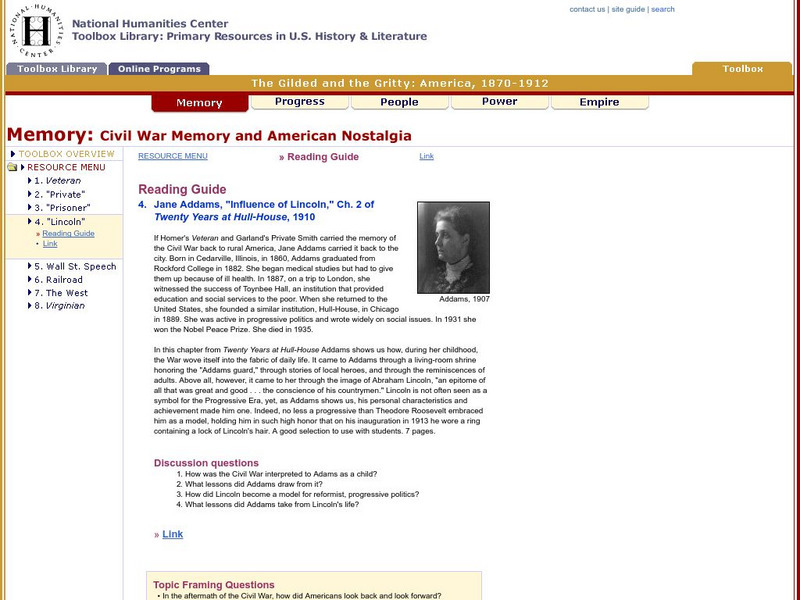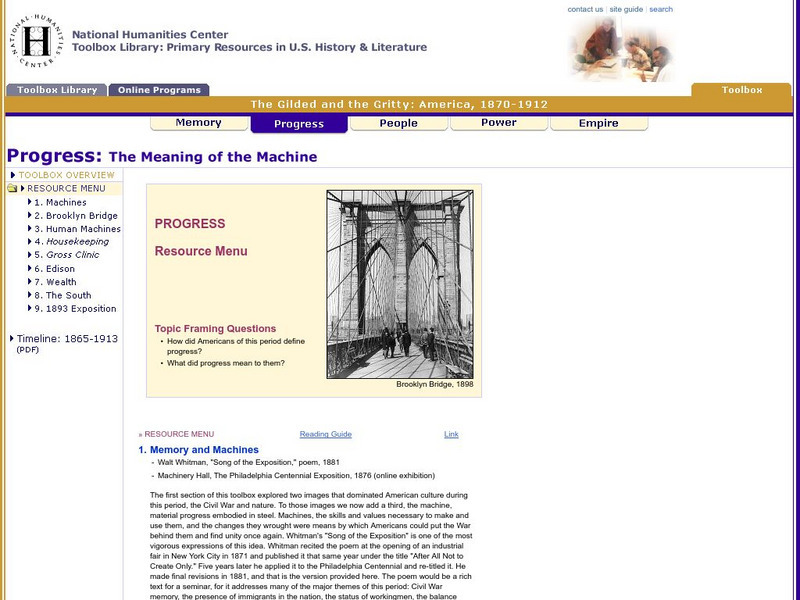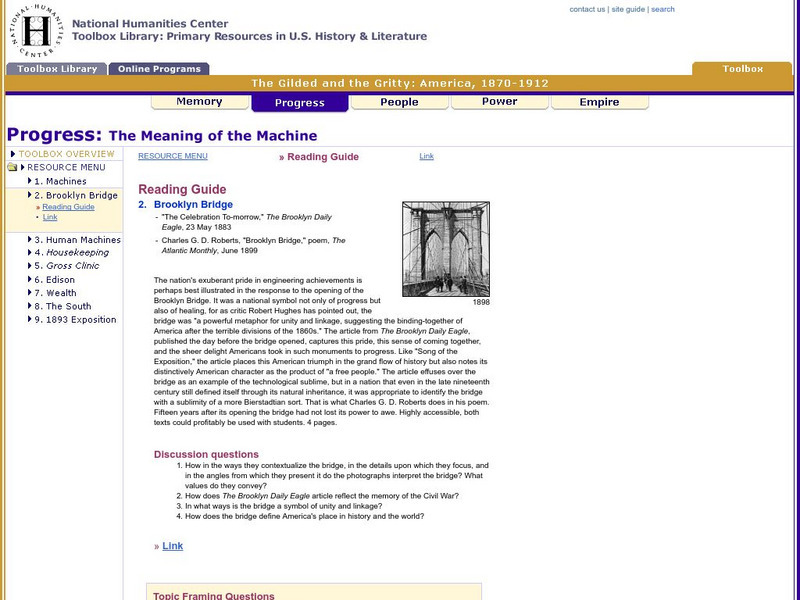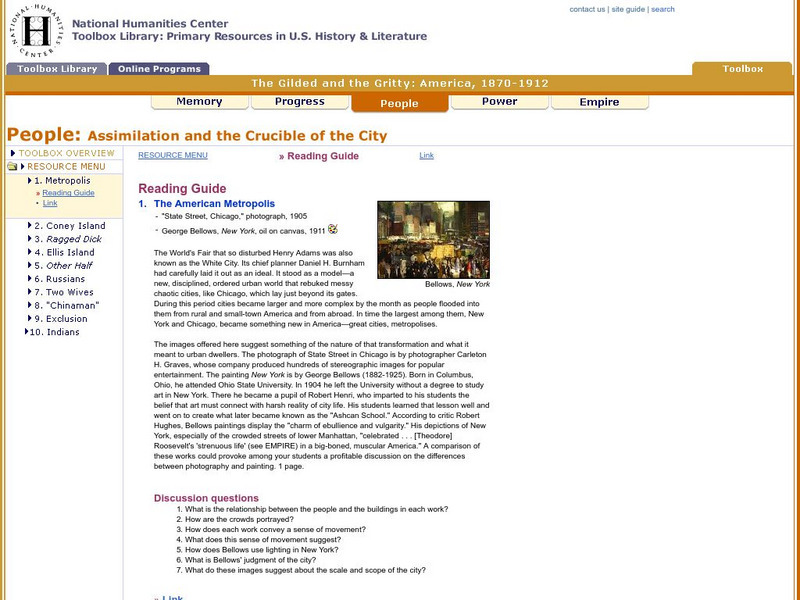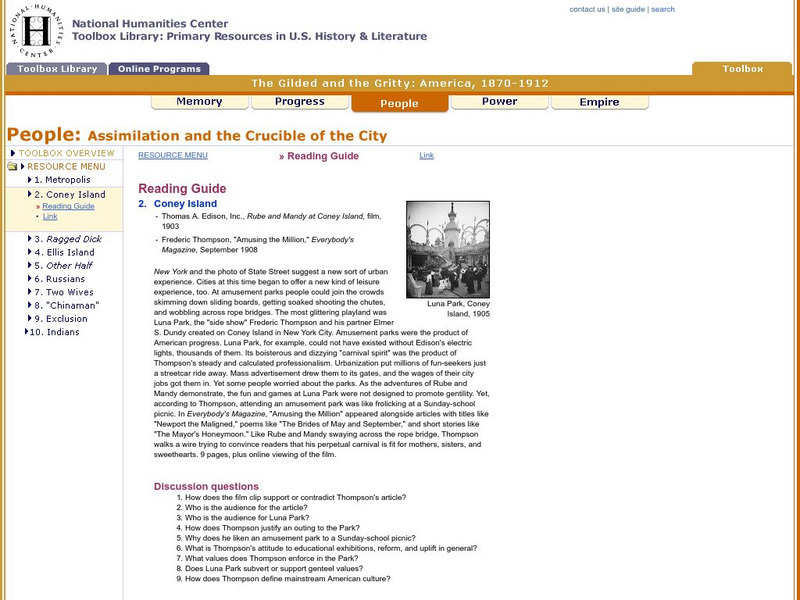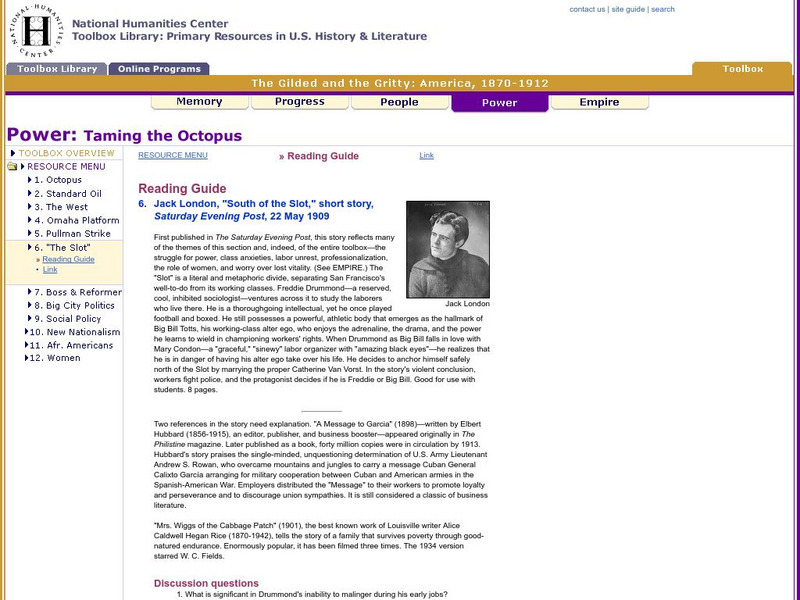National Humanities Center
National Humanities Center: Toolbox Library: Toolbox: America in 1850: Daniel Webster
The National Humanities Center presents collections of primary resources compatible with the Common Core State Standards including Daniel Webster, Speech to the United States Senate, March 7, 1850.
National Humanities Center
National Humanities Center: Toolbox Library: William Seward, Triumph of Nationalism: America, 1815 1850
The National Humanities Center present a reading guide that links to a speech in the Senate by William Seward, one that expresses moral outrage over the compromises allowing the expansion of slavery.
National Humanities Center
National Humanities Center: Toolbox Library: America in 1850: Henry Clay
Collection of primary resource material includes Henry Clay's, "A General Review of the Debate on the Compromise Bills," U.S. Senate, July 22, 1850. With questions for discussion.
National Humanities Center
National Humanities Center: Toolbox Library: Henry David Thoreau: Civil Disobedience: 1848
Thoreau's essay that calls for citizens to break unjust laws, particularly those promoting the continuation and expansion of slavery.
National Humanities Center
National Humanities Center: Toolbox Library: Harriet B. Stowe, Triumph of Nationalism: America, 1815 1850
A fictional depiction of the turmoil over the existence of slavery-and its human impact.
National Humanities Center
National Humanities Center: Toolbox Library: The Gilded and the Gritty: America, 1870 1912
Ninety-four primary sources-historical documents, literary texts, and visual images-that explore the challenges, opportunity, and turmoil of late-nineteenth-century America. They examine the economic expansion in an America re-united...
National Humanities Center
National Humanities Center: Toolbox Library: Memory, the Gilded and the Gritty: America, 1870 1912
Twelve primary sources - historical documents, literary texts, and visual images - that explore ways in which the memory of the Civil War affected American life in the last quarter of the nineteenth century.
National Humanities Center
National Humanities Center: Toolbox Library: Veteran, the Gilded and the Gritty: America, 1870 1912
A poignant Winslow Homer painting (1865) that suggests the psychic state of Civil War veterans.
National Humanities Center
National Humanities Center: Toolbox Library: "Prisoner," the Gilded and the Gritty: America, 1870 1912
Joel Chandler Harris's short story, "Aunt Fountain's Prisoner", that depicts a successful triumph over the challenges of reuniting a country divided by Civil War.
National Humanities Center
National Humanities Center: Toolbox Library: Memory: Civil War Memory and American Nostalgia: Influence of Lincoln
An excerpt from Jane Addams' autobiography "Twenty Years at Hull House" that describes how Abraham Lincoln inspired her urban reform efforts.
National Humanities Center
National Humanities Center: Toolbox Library: Wall Street Speech, the Gilded and the Gritty: America, 1870 1912
A "bloody shirt" speech from Robert Ingersoll that emphasizes the virtue of Republican candidates and attacks Democrats as traitors during the Civil War.
National Humanities Center
National Humanities Center: Toolbox Library: Railroad, the Gilded and the Gritty: America, 1870 1912
A speech and an engraving that illustrate how the railroad helped to unite the country after the Civil War.
National Humanities Center
National Humanities Center: Toolbox Library: Progress, the Gilded and the Gritty: America, 1870 1912
Eighteen primary sources-historical documents, literary texts, and visual images-that explore the industrial, racial, and technological progress of the late-nineteenth century.
National Humanities Center
National Humanities Center: Toolbox Library: Progress: The Meaning of the Machine: Brooklyn Bridge
An essay and a poem about the Brooklyn Bridge that celebrate its power and majesty as emblems of industrial America during the late 1800's.
National Humanities Center
National Humanities Center: Toolbox Library: Gross Clinic, the Gilded and the Gritty: America, 1870 1912
Thomas Eakins's controversial painting that reflects the skill of professional, scientific practitioners during the late-nineteenth century.
National Humanities Center
National Humanities Center: Toolbox Library: Progress: The Meaning of the Machine: Southern Stasis
A survey of the lagging Southern economy of the late-nineteenth century and two speeches, one by a black Southerner and one by a white Southerner, making the case for Northern investment in the region.
National Humanities Center
National Humanities Center: Toolbox Library: People: Assimilation and the Crucible of the City: The American Metropolis
A photograph of State Street in Chicago and George Bellows' painting of Lower Manhattan, both depicting the vigorous, gritty, energetic urban life in the early-twentieth century.
National Humanities Center
National Humanities Center: Toolbox Library: Coney Island, the Gilded and the Gritty: America, 1870 1912
A Thomas Edison film and an essay about the amusement park experience, a new leisure pastime made possible by urbanization and industrialization.
National Humanities Center
National Humanities Center: Toolbox Library: People: Assimilation and the Crucible of the City: Street Life in New York
Excerpt from Horatio Alger's well-known novel, "Ragged Dick, Or, Street Life in New York," that describes the values and attitudes needed to make it in the capitalistic, urban America of the late-nineteenth century.
National Humanities Center
National Humanities Center: Toolbox Library: Assimilation and the Crucible of the City: Reading Guide to Yerzierska
Two short stories from Polish immigrant, Anzia Yerzierska, about the challenges of Americanization that immigrants faced in the early-twentieth century. Includes questions for discussion.
National Humanities Center
National Humanities Center: Toolbox Library: People: Assimilation and the Crucible of the City: Zitkala Sa
A photograph and an autobiographical excerpt about the changes experienced and challenges faced by Native Americans at the turn of the twentieth century.
National Humanities Center
National Humanities Center: Toolbox Library: Pullman Strike, the Gilded and the Gritty: America, 1870 1912
An article that describes the Utopian factory town George Pullman built for his workers, a statement of the grievances that led them to strike against the company, the Pullman Company's response, and an editorial speculating on the...
National Humanities Center
National Humanities Center: Toolbox Library: "The Slot," the Gilded and the Gritty: America, 1870 1912
A short story by Jack London that examines unrest between capital and labor in early-twentieth century San Francisco.
National Humanities Center
National Humanities Center: Toolbox Library: Big City Politics, the Gilded and the Gritty: America, 1870 1912
Ash Can School artist John Sloan's painting Election Night captures the exuberance of urban politics in the early-twentieth century, and artist Henry Glitkencamp's illustration Voting Machines suggests its corrupting power. Both pieces...


